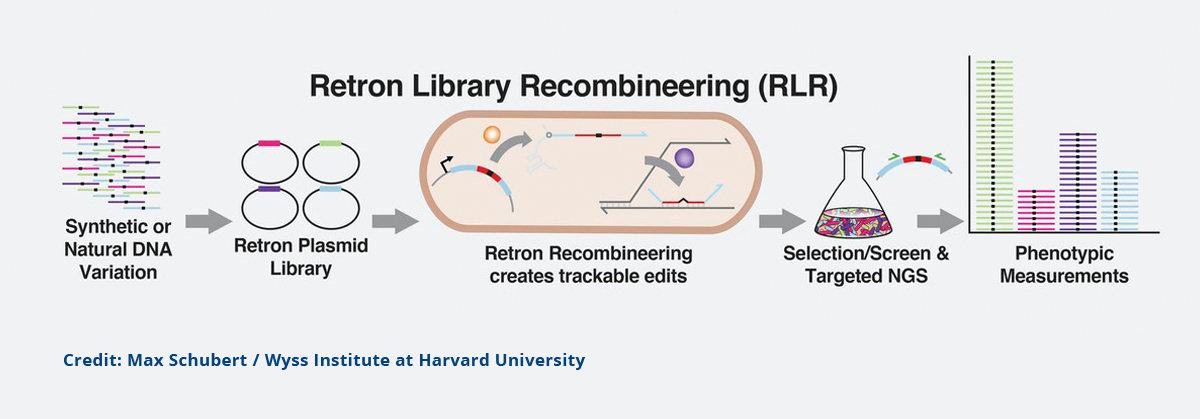
Harvard University Researchers Create New Gene Editing Tool Retron Library Recombineering
May 5, 2021| |
"Move over CRISPR, the retrons are coming!" Researchers at the Wyss Institute for Biologically Inspired Engineering at Harvard University and Harvard Medical School (HMS) have created a new gene editing tool called Retron Library Recombineering (RLR) that enables millions of genetic experiments to be performed simultaneously.
CRISPR-Cas9 can find and cut specific pieces of DNA, but editing the DNA to create desired mutations requires tricking the cell into using a new piece of DNA to repair the break. This bait-and-switch is complicated to orchestrate, and can even be toxic to cells because Cas9 often cuts unintended, off-target sites as well. The RLR tool makes this task easier. RLR generates up to millions of mutations simultaneously, and "barcodes" mutant cells so that the entire pool can be screened at once, enabling massive amounts of data to be easily generated and analyzed.
Retrons have been known for decades, but their functions were unknown until June 2020 when a team finally figured out that retron ssDNA detects whether a virus has infected the cell, forming part of the bacterial immune system. Researchers are interested in retrons because they, like CRISPR, could be used for precise and flexible gene editing in bacteria, yeast, and even human cells. Another attraction of retrons is that their sequences serve as "barcodes" that identify which individuals within a pool of bacteria have received each retron sequence, enabling dramatically faster, pooled screens of precisely-created mutant strains.
"Being able to analyze pooled, barcoded mutant libraries with RLR enables millions of experiments to be performed simultaneously, allowing us to observe the effects of mutations across the genome, as well as how those mutations might interact with each other," said senior author George Church, who leads the Wyss Institute's Synthetic Biology Focus Area.
For more details about RLR, read the article in the Wyss Institute News.
| |
You might also like:
- Two Studies Reveal Retron's Function and its Genome-editing Potential
- Pocket K No. 54: Plant Breeding Innovation: CRISPR-Cas9
- Pocket K No. 59: Plant Breeding Innovation: TALENs
Biotech Updates is a weekly newsletter of ISAAA, a not-for-profit organization. It is distributed for free to over 22,000 subscribers worldwide to inform them about the key developments in biosciences, especially in biotechnology. Your support will help us in our mission to feed the world with knowledge. You can help by donating as little as $10.
-
See more articles:
-
News from Around the World
- UN Agencies Conduct Virtual Consultations to Strategize Hunger Alleviation and Food System Transformation
- Oklahoma State University Scientists Wheat Gene Discovery to Increase Yields
- Study Shows First High-Quality Reference Genome of Hazelnut
- Nanonutrients Protect Crops from Fungal Diseases
- Transgenic Crop Industry in Iran Remains Steady Despite Challenges, Study Finds
- European Commission Study Shows Potential for Agriculture of New Genomic Techniques and Need for New Policy
- Research Confirms GM Grass Cleanses Soil of Toxic Pollutants Left by Military Explosives
-
Research Highlights
- Mutant Maize Gene Gives Clues on Breeding Better Crops
-
Plant
- Scientists Control Fruit Fly Population Using CRISPR
- Research Reveals GORKY Protein Turns Bitter Tomatoes Sweet
- Harvard University Researchers Create New Gene Editing Tool Retron Library Recombineering
- Researchers Explore Off-target Effects of TALEN-mediated Bar-knockout in Rice
-
Read the latest: - Biotech Updates (December 17, 2025)
- Gene Editing Supplement (December 17, 2025)
- Gene Drive Supplement (February 22, 2023)
-
Subscribe to BU: - Share
- Tweet

